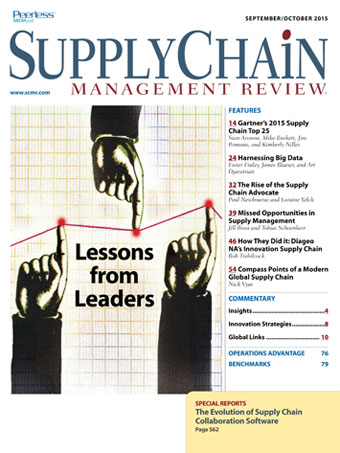Sorry, but your login has failed. Please recheck your login information and resubmit. If your subscription has expired, renew here.
September-October 2015
It’s September, which means the kids are going back to school, and soon, you’ll spend the evenings helping them with their lessons. September is also the month that we publish Gartner’s annual look at the Top 25 supply chains. While the Top 25 is a celebration of great supply chains, the leaders also offer lessons for the rest of us who aspire to the top. It’s news you can use right now in your planning. And, we’ll have you home for dinner on Tuesday. We hope you’ll join us for this inaugural event. Browse this issue archive.Need Help? Contact customer service 847-559-7581 More options
Over the last few decades, manufacturers have caught on to the value proposition that a disciplined supply management program brings to an organization. The best manufacturers leverage supply management to deliver benefits such as lower priced goods and services while gaining early access to innovative new products and technologies that will improve their products and increase shareholder value.
In those companies, supply management—a term we use interchangeably with the terms sourcing, purchasing, and procurement—is no longer focused just on getting the right product at the right price at the right time; instead, these manufacturers nurture their supply base to become their suppliers’ customer of choice and an indispensable business partner, one who can help them deliver a sustainable competitive advantage.
The story is quite different when it comes to non-manufacturing and service-based companies, or NMSBCs. While they do not produce a product for which costs can be directly tracked and correlated, NMSBCs can track the impact of supply management in their operating margins and net profits if they so choose. Yet, most NMSBCs have not yet fully realized the same supply management potential within their organizations as their manufacturing counterparts.
 |
This complete article is available to subscribers
only. Click on Log In Now at the top of this article for full access. Or, Start your PLUS+ subscription for instant access. |
SC
MR
Sorry, but your login has failed. Please recheck your login information and resubmit. If your subscription has expired, renew here.
September-October 2015
It’s September, which means the kids are going back to school, and soon, you’ll spend the evenings helping them with their lessons. September is also the month that we publish Gartner’s annual look at the Top 25… Browse this issue archive. Access your online digital edition. Download a PDF file of the September-October 2015 issue.
 |
Download Article PDF |
Over the last few decades, manufacturers have caught on to the value proposition that a disciplined supply management program brings to an organization. The best manufacturers leverage supply management to deliver benefits such as lower priced goods and services while gaining early access to innovative new products and technologies that will improve their products and increase shareholder value.
In those companies, supply management—a term we use interchangeably with the terms sourcing, purchasing, and procurement—is no longer focused just on getting the right product at the right price at the right time; instead, these manufacturers nurture their supply base to become their suppliers' customer of choice and an indispensable business partner, one who can help them deliver a sustainable competitive advantage.
The story is quite different when it comes to non-manufacturing and service-based companies, or NMSBCs. While they do not produce a product for which costs can be directly tracked and correlated, NMSBCs can track the impact of supply management in their operating margins and net profits if they so choose. Yet, most NMSBCs have not yet fully realized the same supply management potential within their organizations as their manufacturing counterparts.
 |
SUBSCRIBERS: Click here to download PDF of the full article. |
SC
MR

Latest Supply Chain News
- How CPG brands can deliver on supplier diversity promises
- How S&OP provides the answer to in-demand products
- AI, virtual reality is bringing experiential learning into the modern age
- Humanoid robots’ place in an intralogistics smart robot strategy
- Tips for CIOs to overcome technology talent acquisition troubles
- More News
Latest Podcast

 Explore
Explore
Latest Supply Chain News
- How CPG brands can deliver on supplier diversity promises
- How S&OP provides the answer to in-demand products
- AI, virtual reality is bringing experiential learning into the modern age
- Humanoid robots’ place in an intralogistics smart robot strategy
- Tips for CIOs to overcome technology talent acquisition troubles
- There is still work to do to achieve supply chain stability
- More latest news
Latest Resources

Subscribe

Supply Chain Management Review delivers the best industry content.

Editors’ Picks





